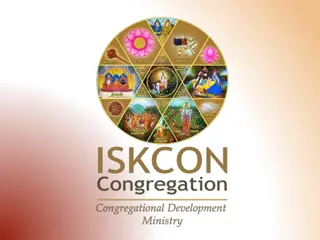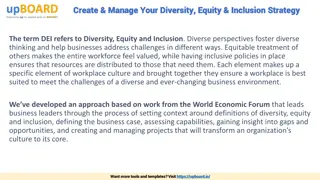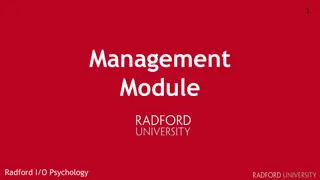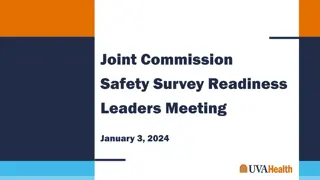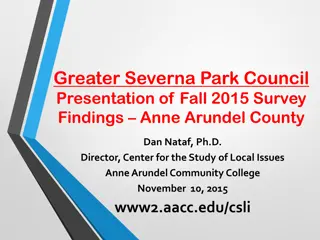NACCC Survey Fall 2020 DEI Month Findings & Recommendations
The NACCC conducted a survey in fall 2020 among 637 Cuesta students, focusing on diversity, equity, and inclusion (DEI) issues. The survey revealed insights on racial demographics, feelings of mattering and affirmation, cross-racial engagement, and areas for improvement. Key findings include varying levels of mattering and affirmation among different racial groups, as well as opportunities to enhance cross-racial engagement on campus. Recommendations include conducting a campus space audit and creating intentional opportunities for cross-racial dialogue.
Download Presentation

Please find below an Image/Link to download the presentation.
The content on the website is provided AS IS for your information and personal use only. It may not be sold, licensed, or shared on other websites without obtaining consent from the author.If you encounter any issues during the download, it is possible that the publisher has removed the file from their server.
You are allowed to download the files provided on this website for personal or commercial use, subject to the condition that they are used lawfully. All files are the property of their respective owners.
The content on the website is provided AS IS for your information and personal use only. It may not be sold, licensed, or shared on other websites without obtaining consent from the author.
E N D
Presentation Transcript
NACCC SURVEY FALL 2020 DEI Month Presentation April 20, 2022 Gabriel Cuarenta-Gallegos, Regina Voge, Madeline Medeiros & Ryan Cartnal
NACCC Survey Background Survey conducted fall 2020 637 Cuesta Students (response rate of 7.21%) Asian: 2.98% (19) Black: 2.83% (18) White: 53.22% (339) Hispanic/Latina/o/x: 19.78% (126) Two or More Races: 17.43% (111) Female: 65.15% (415) Male: 31.24% (199) Other Gender Identity: 3.61% (23)
NACCC Survey Background Six content areas: Mattering and Affirmation Cross-Racial Engagement Racial Learning and Literacy Encounters with Racial Stress Appraisals of Institutional Commitment Impact of External Environments
Limitations and Other Considerations Limitations and Other Considerations Administered Fall 2020 Unsure if students were in person or remote, local or out-of-area Student response rate, 7.21% Voluntary student responses
Mattering and Affirmation Key Finding Students who felt they mostly or strongly matter when present at the campus quad or other common gathering spaces: oHispanic/Latinx: 33% oCaucasian/White: 46%
Mattering and Affirmation Goal Recommended Actions Conduct a space audit of the campus to evaluate how welcoming the space is for students. Include students in the audit. Find and create designated spaces where URM student groups (clubs, programs) can meet. Increase the overall sense of mattering and affirmation for racially minoritized students in dominant social spaces significant to student life outside of the classroom.
Cross Racial Engagement Key Finding Key Finding Students who felt completely open to engage in conversations about race with Caucasian/White Students: Students who participated in student clubs or organizations with students of color: oWhite Students: 28% oWhite Students: 27% oBlack/African American: 16% oHispanic/Latinx: 19% oHispanic/Latinx: 7% oBlack/African American: 16%
Cross Racial Engagement Goal Recommended Actions Create intentional, facilitated opportunities for cross-racial engagement on campus. Host inter- and intragroup dialogues with skilled facilitators where privilege and marginality are discussed. Facilitate meaningful dialogues inside and outside of classroom discussion in which racially minoritized students' perspectives and experiences are also centered.
Racial Learning and Literacy Key Finding Key Finding Students who reported Cuesta is mostly or strongly preparing them to work in a racially diverse setting: Students of color who reported they learned about race from: oWhite Professors: 37% oProfessors of Color: 26% oAsian: 38% White students who reported they learned about race from: oWhite Professors: 40% oProfessors of Color: 28% oBlack: 29% oWhite: 36% oHispanic/Latinx: 37%
Racial Learning and Literacy Goals Recommended Actions Organize a conference around race and racism as it relates to Cuesta and SLO County. Provide discipline-specific sessions (in addition to JEDI training) during opening week where faculty are more likely to attend. Provide divisions with material to discuss during division meetings. Increase racial learning opportunities for students and staff. Increase student exposure to race and social justice issues in the classroom.
Encounters with Racial Stress Key Findings The overall racial environment at Cuesta has resulted in a decline in my academic performance/grades: oWhite: 4%; Black/African American: 9%; Hispanic/Latinx: 26% The overall racial environment at Cuesta has resulted in feelings of loneliness, not belonging, and/or isolation: oWhite: 12%; Black/African American: 54%; Hispanic/Latinx: 40%
Encounters with Racial Stress Key Findings Racial incidents at Cuesta have resulted in a decline in my academic performance/grades: oWhite: 8%; Black/African American: 50%; Hispanic/Latinx: 30% a decline in my emotional wellbeing: oWhite: 18%; Black/African American: 50%; Hispanic/Latinx: 35% feelings of loneliness, not belonging, and/or isolation: oWhite: 11%; Black/African American: 100%; Hispanic/Latinx: 55%
Encounters with Racial Stress Recommended Actions Goal Provide ongoing professional development for faculty and staff to: Significantly reduce, if not entirely eliminate, the frequency with which students experience racial stress by disrupting oppressive practices and providing support for those on the margins. prioritize understanding of the effects of racial violence on students; prioritize understandings of microaggressions and their impact on learning and well-being; develop the skills to confront and intervene when microaggressions occur; prioritize a consistent message to all students that they are intelligent, of worth, and capable of scholarship. Survey students for ideas on creating safe spaces on campus that will better serve minoritized students.
Appraisals of Institutional Commitment Key Finding Key Finding Cuesta is strongly committed to hiring faculty of color: Cuesta is strongly committed to sponsoring activities about racial diversity: oWhite Students: 51% oWhite Students: 32% oHispanic/Latinx: 37% oHispanic/Latinx Students: 23% oBlack/African American Students: 18% oBlack Students: 13%
Appraisals of Institutional Commitment Goals Recommended Actions Continually assess equitable hiring practices and integrate proactive mea- sures throughout the hiring process. Establish programs for ensuring greater retention and sense of belonging of Cuesta's racially diverse faculty and staff. Practice race-conscious leadership; engage in authentic conversations and collaborations with people of color and develop an accurate understanding of the realities of race on campus. Achieve parity in the racial composition of Cuesta faculty that mirrors student racial demographics, particularly that of our Hispanic/Latina/o/x student body. As a Hispanic Serving Institution, actively sponsor activities and events that promote racial diversity and that highlight our Hispanic/Latina/o/x student body and community.
Impact of External Environments Key Finding Key Finding I have often or almost always personally experienced racism in the city/town surrounding my campus: I have experienced a decline in my academic performance or grades due to personally experienced racist encounters: oWhite Students: 9% oWhite Students: 8% oHispanic/Latinx Students: 18% oHispanic/Latinx Students: 7% oBlack Students: 10% oBlack/African American Students: 14%
Impact of External Environments Key Finding Key Finding I have experienced a decline in my emotional well-being due to personally experienced racist encounters: I have experienced an increase in feelings of frustration or anger due to personally experienced racist encounters: oWhite Students: 53% oWhite Students: 27% oHispanic/Latinx Students: 57% oHispanic/Latinx Students: 31% oBlack Students: 50% oBlack/African American Students: 10%
Impact of External Environments Goal Recommended Actions Prepare to support students who have already experienced racial battle fatigue when they first arrive on our campus, and support students who face anxieties about physical safety and well-being of their loved ones back in their hometown communities. Distribute messaging and notifications to the campus community when incidents of racism and hate crimes happen locally or nationally. As a college, be proactive and remain aware that students come from and are continually exposed to environments with differing levels of racial stress and violence apart from the campus community and may experience a separate racial reality on campus than in their hometown or in the greater communities surrounding our campuses.
Questions to Consider Questions to Consider Which data is most significant for your area? What other goals should we consider? Which actions are most important for us to take now? What additional actions should we take individually, in our departments, or as a college?





